


 النبات
النبات
 الحيوان
الحيوان
 الأحياء المجهرية
الأحياء المجهرية
 علم الأمراض
علم الأمراض
 التقانة الإحيائية
التقانة الإحيائية
 التقنية الحيوية المكروبية
التقنية الحيوية المكروبية
 التقنية الحياتية النانوية
التقنية الحياتية النانوية
 علم الأجنة
علم الأجنة
 الأحياء الجزيئي
الأحياء الجزيئي
 علم وظائف الأعضاء
علم وظائف الأعضاء
 الغدد
الغدد
 المضادات الحيوية
المضادات الحيوية|
Read More
Date: 4-11-2015
Date: 4-11-2015
Date: 4-11-2015
|
BIO-DIVERSITY: ANIMAL GROUPS
A- Methods of grouping animals
There are several ways of grouping animals. In all these methods the basic Taxon remains without any change. However the taxa are rearranged in different groups. All these groupings are mostly provided for the convenience in identifying similar taxa.
I. One of the earliest methods of grouping the animals could be dividing the Animal kingdom into two assemblages called Invertebrate and Vertebrata.
This scheme was provided initially by Aristotle. This scheme does not have a place for the Prochordates.
II. Animals can also be grouped as single celled and multicellular. The single celled organisms are called the Protozoans. The multicellular could be called the Metazoans. In this arrangement among the metazoans the unique nature of the sponges in not having a tissue grade of body construction is not mentioned.
III. In yet another method the animals are grouped under following three assemblages.
1-Protozoa - single celled animals
2-Parazoa - Multicellular without tissue grade (sponges)
. 3-Eumetazoa - Multicellular with tissue grade
Eumetazoa is a large group including most of the multicellular animals. Hence it is subdivided further into two groups
1-Diploblastic animals - having ectoderm and entoderm as two layers in the body wall. Ex: Coelenterata
2-Triploblastic animals - having ectoderm, mesoderm and endoderm as three layers in the body wall.

Fig. 1.2.1: Coelomic cavity.
The Triploblastic animals are further divided into three groups based on the presence or absence of an embryonic body cavity called coelom.
1-Acoelomata - no coelom Ex: Platyhelminthes
2-Pseudocoelomata - with a false coelom Ex: Nematoda
3-Coelomata - with a true coelom
IV. In a recent system, the entire living world is subdivided into 5 kingdoms. This system is much more broader including algae, fungi, and plants. It is known as the five kingdom concept
1-Kingdom: Monera - It includes all bacteria and the cyanobacteria. A circular DNA occurs in the cytoplasm. The cell wall is a rigid structure. a) Phylum: Cyanobacteria b) Phylum: Bacteria.
2-Kingdom: Protoctista or Protista - It includes single celled eukaryotes. It has two subkingdoms, namely Protozoa and Algae.
3-Kingdom: Fungi
4-Kingdom: Plantae (green plants
5-Kingdom: Animalia: multicellular, eukaryotic animals
B- Major phyla
Phylum: Protozoa
This phylum includes a great diversity of small, microscopic organ-isms. These are single celled eukaryotes. Their locomotion happens using pseudopodia, cilia or flagella.
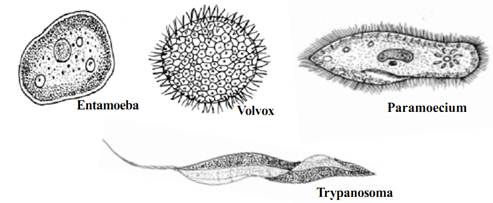
Fig. 1.2.2 Protozoans
The nutrition is either autotrophic or heterotrophic. They reproduce either asexually or by sexual methods. Ex: Amoeba, Paramecium, Plasmodium.
Phylum: Porifera
These are multicellular, aquatic organisms. They have a cellular grade of construction without the occurrence of tissues. The sponges belonging to this phylum are characterized by the presence of a canal system in their body. The body wall contains spicules. They can reproduce both by asexual and sexual methods. Ex: Sponges.

Phylum: Coelenterata or Cnidaria

All coelenterates are aquatic animals. They are mostly marine. The body is radially symmetrical. The body wall is of two layers of cells. The outer layer is called the ectoderm. The inner layer, entoderm is separated from the ectoderm by a non-cellular mesogloea. The mesogloea is a jelly-like substance. Due to the presence of two layers in the body wall, these are said to be diploblastic animals.
Many coelenterates exhibit polymorphism. In this phylum, organisms exist in two different body forms namely, a polyp, and a medusa. The ectoderm contains stinging cells called nematocysts (cnidoblasts). These cells when triggered can explosively penetrate prey and inject poison.
The layers in the body wall contain several cells and tissues such as muscle cells epithelial tissues, gland-cells and sensory cells.
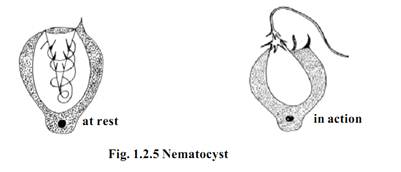
They reproduce both asexually and sexually. They are divided into three classes, namely Hydrozoa, Scyphozoa and Anthozoa. In Hydrozoa, the animal has a dominant polyp body form and a reduced medusa stage. (e.g) Hydra, Obelia.
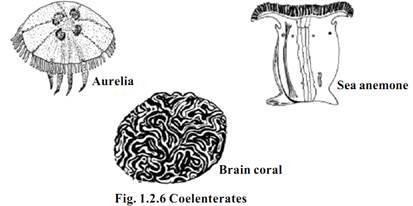
In Scyphozoa the medusa form is permanent. This group includes jelly fishes such as Aurelia. They swim in the surface waters. They have a bell shaped medusa stage.
The Anthozoans mostly remain as polyps. Their body cavity is divided by large radial partitions called mesenteries. (eg) sea-anemone and corals.
1-All animals of subsequent phyla show the following general characters. All of them have three layers in the body wall. They are named as outer ectoderm, middle mesoderm, and inner endoderm. Thus they are called as triploblastic animals.
2-The body is bilaterally symmetrical
Phylum: Platyhelminthes
This phylum includes flatworms. These are acoelomates, without a body cavity called coelom. The alimentary canal is either absent or very simple. Excretion and osmoregulation occur through flame cells. These worms are mostly hermophrodites, having both male and female reproductive organs in a single individual. Most of the members are parasites. It is divided into three classes, namely Turbellaria, Trematoda and Cestoda.

Class Turbellaria :- These are free living aquatic flatworms. The Planaria of this class shows characteristic regeneration.
Class Trematoda :- These are flukes living as parasites inside a host (en- doparasites). A protective cuticle covers the outer surface of the body. Flukes have suckers for attachment to the host tissues. The examples are Fasciola (liver fluke), Schistosoma (blood fluke).
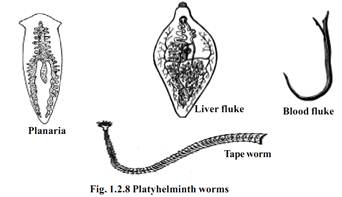
Class Cestoda: - It includes all tape worms. These are internal parasites with a complex life history. The life cycle involves two hosts.
Their body characters are adaptations for parasitic life. Mouth and alimentary canal are absent. Food is absorbed through general body surface. The head is called the scolex. It has a ring of hooks and suckers for attachment to the host tissue. The body consists of several segments called Proglottids. (eg) sheep and cattle tape worms.
Phylum: Nematoda:-
These are the popular round worms. The body is narrow and pointed at both the ends. There are no body segments. The body is covered by a thin cuticle. The body cavity is considered as a pseudocoelom. The alimentary canal is a straight tube. They reproduce sexually and the sexes are separate. There are several free living soil nematodes. Others are parasites. (eg) Ascaris lumbricoides.
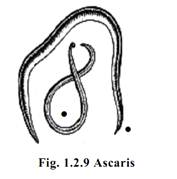
In subsequent Phyla the animals show following general characters
1-There is a coelom within the mesoderm. Hence these are called as coelomates.
2-The body consists of a series of compartments. This phenomenon is called as metameric segmentation. They have a circulatory system pro-viding internal transport.
Phylum: Annelida:-
These are worm like animals. The body segments are rings externally. Internally the segments are separated by septa. Externally the body is protected by a cuticle. Excretion and osmoregulation are achieved by ciliated tubules called nephridia. There is a central nervous system. The brain is formed of ganglia in the head region. The nerve cord is ventral in position. For the first time head formation or cephalization happens. These are bisexual and hermophroditic. The larva is called the trochophore.

This phylum includes three Classes, namely Polychaeta, Oligochaeta and Hirudinia. The polychaetes are marine worms. They have a distinct head. There are pairs of lateral projections called parapodia. The examples are Nereis (ragworms), Arenicola (lugworm).
Earthworms are included in the Class Oligochaeta. The Class: Hirudinia includes leeches. These are blood suckers and ectoparasites. They have well developed suckers for attachment at anterior and posterior ends.

Phylum: Arthropoda:-
These are the most successful group of animals. They outnumber all other animals in population strength. The body is segmented. It is covered by a hard exoskeleton made of chitin. During growth the exoskeleton is shed (moulting of ecdysis). The legs or paired appendages are jointed. The head region has a pair of prominent compound eyes. Each compound eye is made up of several photoreceptor sub units called Ommatidia.
They have an open circulatory system without vessels. The body cavity is filled with a fluid called haemolymph. Such body cavity is known as haemocoel. These are unisexual, exhibiting sexual dimorphism. The young forms produced are invariably called the larvae. The larvae undergo metamorphosis and develop into adults.
This Phylum comprises five Classes, Class Onychophora: It includes small worm like Peripatus. Peripatus shows Annelidan and Arthropoda characters. Hence this may be considered as a connecting link between the two groups.
Class Crustacea: - The examples for this class are prawns, crabs and lobsters. The dorsal body surface is covered by a shield like carapace.

Class Myriapoda: - It includes centepedes and millipedes. These organisms have a distinct head and simple eyes. The centepedes have a pair of poison claws. The body consists of numerous segments, bearing pairs of legs.

Class Insecta:-It comprises the common insects. The body is divided into head thorax and abdomen .In several insects, the adults have two pairs of wings on the thorax. Respiration happens through the tracheal system.
Class Arachnida: - It includes scorpions, spiders, ticks and mites. The body is divided into cephalothorax and abdomen. There are four pairs of legs attached to the cephalothorax.
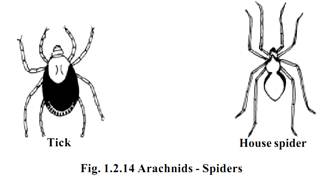
Phylum Mollusca: - It is a very successful and diverse group of animals. Considered to be the second largest group of animals with regard to species number. These are soft bodied animals without segmentation. The body is divided into head, muscular foot and visceral mass. The body is covered by a mantle and a shell.
Respiration happens through gills (ctinidia) in the mantle cavity. The most common larva is a trochophore larva.
There are seven classes of which three are more prominent
Class Pelecypoda or Bivalvia: - These are aquatic molluscs having bivalves. They burrow in mud and sand. The body is laterally compressed. (eg) mussels, clams, oysters.
Class Gastropoda: - These are either aquatic or terrestrial molluscs. They possess a spiral shell
The foot is large and flat. They have well developed head with tentacles and eyes. (eg) snails, slugs, and limpets.
Class Cephalopoda: - These are mostly marine. They are adapted for swimming. The foot is modified into eight to ten long tentacles in the head region. The shell is either internal or absent. (eg) Octopus, Loligo, Sepia.

Fig. 1.2.15 Molluscs
References
T. Sargunam Stephen, Biology (Zoology). First Edition ,Government of Tamilnadu.(2015) .



|
|
|
|
مخاطر عدم علاج ارتفاع ضغط الدم
|
|
|
|
|
|
|
اختراق جديد في علاج سرطان البروستات العدواني
|
|
|
|
|
|
|
مدرسة دار العلم.. صرح علميّ متميز في كربلاء لنشر علوم أهل البيت (عليهم السلام)
|
|
|